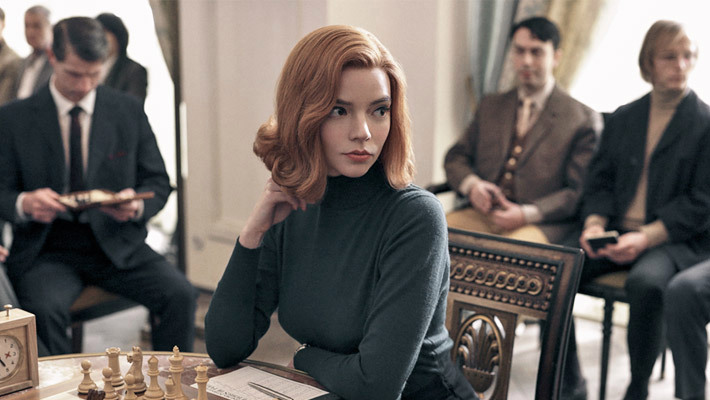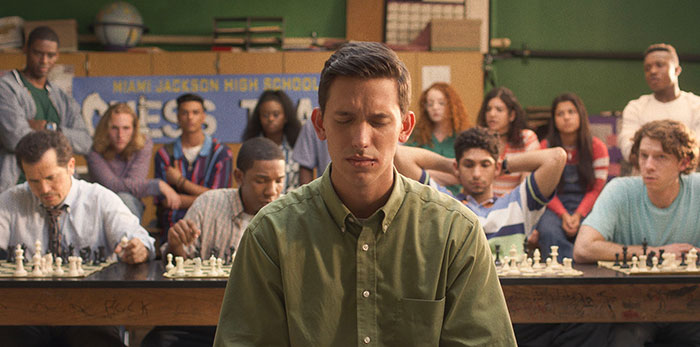The Queen’s Gambit, written by Walter Tevis, was published in 1983. On October 23, 2020, The Queen’s Gambit debuts as a Netflix series. Its main character is a teenaged girl who excels in chess tournaments. Although The Queen’s Gambit is set in the 1950s and 1960s, its perspective on females in chess is still relevant today.

I first read The Queen’s Gambit when I was a teenage chess expert, a lesser prodigy than the book’s main character, Beth Harmon. I noticed that what happened to Beth had happened to me too. Like Beth, I had been told that “Girls don’t play chess.” Her first menstrual period began during a tournament chess game; mine did too. When I was interviewed for my chess accomplishments, I was asked less about chess and more about “girl stuff,” such as whether I had a boyfriend. Same scenario for the questions that journalists asked Beth.
Rereading Tevis’s book in 2020, I thought less about how my personal life had matched Beth’s and more about how girls and women are evaluated. My new emphasis was likely because of this month’s chess stories. On October 13, FIDE Vice President and former World Chess Championship Challenger Nigel Short reiterated that he believes women will always be inferior to men at chess. He said, “In a lot of countries, at undergrad level, women are doing better. But in chess, it is just not the case. We’re talking about a yawning chasm of abilities. You cannot massage this fact to put a spin on it.” He believes that men’s and women’s brains are different. For Short, nature is the inescapable reason that women will always be worse at chess than men.
On October 10, 2020, former World Chess Champion Garry Kasparov, in his Global Chess Festival interview with Grandmaster Judit Polgár, said “the facts are we don’t see any female player coming close to Judit Polgár….I am not expecting anyone like you [Judit Polgár] anytime soon.” Kasparov said that societal reasons (centuries of discrimination, current expectations of coaches and parents) might explain women’s lesser chess achievements. However, for Kasparov, the reasons do not matter because the facts show that women are worse than men in chess.
The film Critical Thinking is based on the true story of the Miami Jackson High School chess team winning the 1998 National High School Championship. The film’s star and director John Leguizamo stated, “In the 1990s, I read a horrible book called ‘The Bell Curve.’ It used pseudo-science and false assumptions to try to prove that Latin and Black people were intellectually inferior due to their genetics.” In 2020, it would be unacceptable to suggest that Latin and Black people could not achieve the highest levels in chess. Yet it is apparently acceptable to claim that women will never reach the highest chess levels. Racism in chess is offensive, but sexism in chess is mainstream.

Just as the fictional Beth Harmon is called an “outlier,” the Mint reporter stated that Short “said he stood by his thesis about men being generally better players than women, that those like Judit Polgar were but outliers.” Being an outlier, or an outsider, is not a comfortable feeling. As Beth listens to two male players talk about a chess opening, she felt “something unpleasant and familiar: the sense that chess was a thing between men, and she was an outsider. She hated the feeling.”
Although I have not yet watched the Netflix series The Queen’s Gambit and the film Critical Thinking, I expect that both will highlight what outsiders felt in tournament chess in the 1950s, 1960s, and in the late 1990s. Those feelings are still present in 2020, making the videos likely very relevant and watchable today.
However, women might not always be outliers and outsiders in chess. An analogy to my daughter’s career might be illustrative. Clarissa is a veterinarian, a profession that is now preponderantly women. However, a little more than a century ago, all but a handful of veterinarians were men. Susan Jones wrote, “In 1900, the masculine culture of veterinary medicine meant that no woman who wanted to retain her femininity could join the profession.”
Likewise, women who play chess are often characterized as unfeminine. For example, read the insults collected by US Chess Women’s Program Director Jennifer Shahade for her artwork “Not Particularly Beautiful.” Shahade wrote that its title square is from a YouTube comment about Shahade, “She is Not Particularly Beautiful At All.” To choose chess means to have one’s beauty (femininity) questioned. That may be one reason that journalists, real and fictional, pester teenage girl chess whizzes with questions about whether or not they have attracted boyfriends.
Of course, Susan Jones lists other reasons for the lack of women veterinarians in the early 20th century, just as there are reasons, beyond being evaluated as unfeminine, for the shortage of women in chess. It’s beyond the scope of this article to list and discuss all those reasons. However, fields of endeavor (veterinary medicine, chess) may change over time. It’s too soon to count women out in chess.
As this infographic illustrates and as Dr. Wei Ji Ma points out in his ChessBase article, women are performing as expected in chess considering their currently low participation numbers. If, in the future, there is greater female participation in chess, there will likely also be more top players who are women.
